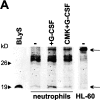G-CSF-stimulated neutrophils are a prominent source of functional BLyS
- PMID: 12566413
- PMCID: PMC2193843
- DOI: 10.1084/jem.20021343
G-CSF-stimulated neutrophils are a prominent source of functional BLyS
Abstract
B lymphocyte stimulator (BLyS) is a novel member of the TNF ligand superfamily that is important in B cell maturation and survival. We demonstrate that human neutrophils, after incubation with G-CSF or, less efficiently, IFN gamma, express high levels of BLyS mRNA and release elevated amounts of biologically active BLyS. In contrast, surface expression of the membrane-bound BLyS was not detected in activated neutrophils. Indeed, in neutrophils, uniquely among other myeloid cells, soluble BLyS is processed intracellularly by a furin-type convertase. Worthy of note, the absolute capacity of G-CSF-stimulated neutrophils to release BLyS was similar to that of activated monocytes or dendritic cells, suggesting that neutrophils might represent an important source of BLyS. In this regard, we show that BLyS serum levels as well as neutrophil-associated BLyS are significantly enhanced after in vivo administration of G-CSF in patients. In addition, serum obtained from two of these patients induced a remarkable accumulation of neutrophil-associated BLyS in vitro. This effect was neutralized by anti-G-CSF antibodies, indicating that G-CSF, present in the serum, stimulated neutrophils to produce BLyS. Collectively, our findings suggest that neutrophils, through the production of BLyS, might play an unsuspected role in the regulation of B cell homeostasis.
Figures














Similar articles
-
Proinflammatory mediators elicit secretion of the intracellular B-lymphocyte stimulator pool (BLyS) that is stored in activated neutrophils: implications for inflammatory diseases.Blood. 2005 Jan 15;105(2):830-7. doi: 10.1182/blood-2004-02-0564. Epub 2004 Sep 9. Blood. 2005. PMID: 15358625
-
Tumor necrosis factor alpha activates release of B lymphocyte stimulator by neutrophils infiltrating the rheumatoid joint.Arthritis Rheum. 2007 Jun;56(6):1776-86. doi: 10.1002/art.22697. Arthritis Rheum. 2007. PMID: 17530706 Free PMC article.
-
Synthesis and release of B-lymphocyte stimulator from myeloid cells.Blood. 2001 Jan 1;97(1):198-204. doi: 10.1182/blood.v97.1.198. Blood. 2001. PMID: 11133761
-
Regulation of B-cell-activating factor (BAFF)/B lymphocyte stimulator (BLyS) expression in human neutrophils.Immunol Lett. 2008 Feb 15;116(1):1-6. doi: 10.1016/j.imlet.2007.11.009. Epub 2007 Dec 7. Immunol Lett. 2008. PMID: 18155301 Review.
-
G-CSF-stimulated PMN in immunotherapy of breast cancer with a bispecific antibody to Fc gamma RI and to HER-2/neu (MDX-210).J Hematother. 1995 Oct;4(5):415-21. doi: 10.1089/scd.1.1995.4.415. J Hematother. 1995. PMID: 8581378 Review.
Cited by
-
New helping friends for B cells.Eur J Immunol. 2012 Aug;42(8):1956-68. doi: 10.1002/eji.201242594. Eur J Immunol. 2012. PMID: 22865046 Free PMC article. Review.
-
Belimumab in systemic lupus erythematosus: an update for clinicians.Ther Adv Chronic Dis. 2012 Jan;3(1):11-23. doi: 10.1177/2040622311424806. Ther Adv Chronic Dis. 2012. PMID: 23251765 Free PMC article.
-
BLyS levels correlate with vaccine-induced antibody titers in patients with glioblastoma lymphodepleted by therapeutic temozolomide.Cancer Immunol Immunother. 2013 Jun;62(6):983-7. doi: 10.1007/s00262-013-1405-y. Epub 2013 Apr 17. Cancer Immunol Immunother. 2013. PMID: 23591978 Free PMC article.
-
Recent advances on the crosstalk between neutrophils and B or T lymphocytes.Immunology. 2019 Jan;156(1):23-32. doi: 10.1111/imm.13005. Epub 2018 Oct 10. Immunology. 2019. PMID: 30259972 Free PMC article. Review.
-
Characterization and allergic role of IL-33-induced neutrophil polarization.Cell Mol Immunol. 2018 Aug;15(8):782-793. doi: 10.1038/cmi.2017.163. Epub 2018 Mar 5. Cell Mol Immunol. 2018. PMID: 29503441 Free PMC article.
References
-
- Moore, P.A., O. Belvedere, A. Orr, K. Pieri, D.W. LaFleur, P. Feng, D. Soppet, M. Charters, R. Gentz, D. Parmelee, et al. 1999. BLyS: member of the tumor necrosis factor family and B lymphocyte stimulator. Science. 285:260–263. - PubMed
-
- Rolink, A.G., and F. Melchers. 2002. BAFFled B cells survive and thrive: roles of BAFF in B-cell development. Curr. Opin. Immunol. 14:266–275. - PubMed
-
- Mackay, F., and J.L. Browning. 2002. BAFF: a fundamental survival factor for B cells. Nat. Rev. Immunol. 2:465–475. - PubMed
-
- Nardelli, B., O. Belvedere, V. Roschke, P.A. Moore, H.S. Olsen, T.S. Migone, S. Sosnovtseva, J.A. Carrell, P. Feng, J.G. Giri, and D.M. Hilbert. 2001. Synthesis and release of B-lymphocyte stimulator from myeloid cells. Blood. 97:198–204. - PubMed
Publication types
MeSH terms
Substances
LinkOut - more resources
Full Text Sources
Other Literature Sources
Medical

